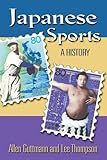Japanese Sports : A History / Lee Thompson, Allen Guttmann.
Material type: TextPublisher: Honolulu : University of Hawaii Press, [2001]Copyright date: ©2001Description: 1 online resource (320 p.)Content type:
TextPublisher: Honolulu : University of Hawaii Press, [2001]Copyright date: ©2001Description: 1 online resource (320 p.)Content type: - 9780824863128
- 796/.0952 22/eng/20230216
- GV655 .G88 2001
- online - DeGruyter
| Item type | Current library | Call number | URL | Status | Notes | Barcode | |
|---|---|---|---|---|---|---|---|
 eBook
eBook
|
Biblioteca "Angelicum" Pont. Univ. S.Tommaso d'Aquino Nuvola online | online - DeGruyter (Browse shelf(Opens below)) | Online access | Not for loan (Accesso limitato) | Accesso per gli utenti autorizzati / Access for authorized users | (dgr)9780824863128 |
Frontmatter -- Contents -- Acknowledgments -- Introduction -- Part I. Sporting Practices Before the Black Ships -- 1. Sumō, Ball Games, and Feats of Strength -- 2. Martial Techniques -- Part II. Modern Times -- 3. The Arrival and Diffusion of Western Sports -- 4. The Modernization of Indigenous Sports -- 5. Japan at the Olympics: 1912–1940 -- 6. From Taishō Democracy to Japanese Fascism -- Part III. Postwar Sports -- 7. Rising from the Ashes -- 8. Japan at the Olympics: 1952–1998 -- 9. New Directions -- Notes -- Bibliography -- Index -- About the Authors
restricted access online access with authorization star
http://purl.org/coar/access_right/c_16ec
In this first synthetic, comprehensive survey of Japanese sports in English, the authors are attentive to the complex and fascinating interaction of traditional and modern elements. In the course of tracing the emergence and development of sumo, the martial arts, and other traditional sports from their origins to the present, they demonstrate that some cherished "ancient" traditions were, in fact, invented less than a century ago. They also register their skepticism about the use of the samurai tradition to explain Japan's success in sports. Special attention is given to Meiji-era Japan's frequently ambivalent adoption and adaptation of European and American sports--a particularly telling example of Japan's love-hate relationship with the West. The book goes on the describe the history of physical education in the school system, the emergence of amateur and professional leagues, the involvement of business and the media in sports promotion, and Japan's participation in the Olympics.Japanese Sports Trivia Quiz (openli)Japan's first professional baseball team was founded in 1921. When were the Central and Pacific Leagues established? a. 1930; b. 1940; c. 1950; d. 1960 (openli)Oh Sadaharu hit 51 home runs in 1973 and 49 in 1974. How many did he hit in his lifetime? a. 597; b. 602; c. 755; d. 868 (openli)Sugiura Tadashi pitched 42 games for the Nankai Hawks in 1959 and won 38. How many games did he pitch and win against the Yomiuri Giants in the Japan Series that same year? a. 1; b. 2; c. 3; d. 4 (openli)The first Japanese radio broadcast of an entire sports event occurred at the national middle-school baseball tournament at Koshien Stadium in 1927, with a Ministry of Communication censor standing by since the script couldn't be approved in advance. The national middle-school tournament was suspended in 1941. When was it resumed? a. 1945; b. 1946; c. 1947; d. 1948 (openli)In 1791 Shogun Tokugawa Ienari observed a new ring-entering ceremony similar to that now performed by yokozuna. When did the Sumo Association officially recognize the rank of yokozuna? a. 1789; b. 1890; c. 1909; d. 1951 (openli)Which famous sumo rikishi won 69 successive bouts over the course of 7 tournaments, the longest winning streak ever recorded? a. Futabayama (Sadaji); b. Wakanohana (Kanji); c. Taiho (Koki); d. Chiyonofuji (Mitsugu) (openli)When the first karate dojo was established in Okinawa in 1889, the characters for karate were written 'Chinese hand'. When were they first written 'empty hand'? a. 1889; b. 1922; c. 1929; d. 1935 (openli)Only one major school of aikido holds competitive tournaments. When did the name aikido first appear on the list of government-sanctioned martial arts. a. 1883; b. 1890; c. 1931; d. 1942 (openli)In 1951 Tanaka Shigeki became the first Japanese runner to win the Boston Marathon. When was the first Fukuoka Marathon held? a. 1927; b. 1937; c. 1947; d. 1957 (openli)At the infamous 1936 "Nazi Olympics" in Berlin, Japanese athletes won gold medals in track and field, swimming, and diving. In what event did a Korean win the gold for Japan? a. marathon; b. triple jump; c. pole vault; d. 1500-m freestyleAnswers: 1. c. (the Pacific League was the expansionleague); 2. d. (Japanese ballparks are shorter than U.S. parks, but theseason is also shorter); 3. d. (his arm never recovered from that year);4. b.; 5. c. (the rank "yokozuna" first appeared on the banzuke ratingsin 1890; and the first solo ring-entering ceremonies by wrestlerswearing the "yokozuna" rope was in 1789); 6. a.; 7. c. (by members ofKeio's karate club who were impressed by a Zen priest of the Rinzaisect); 8. d. (its founder Uesh
Mode of access: Internet via World Wide Web.
In English.
Description based on online resource; title from PDF title page (publisher's Web site, viewed 26. Apr 2024)


